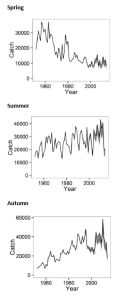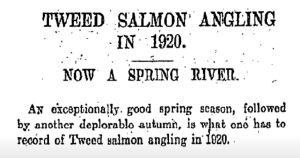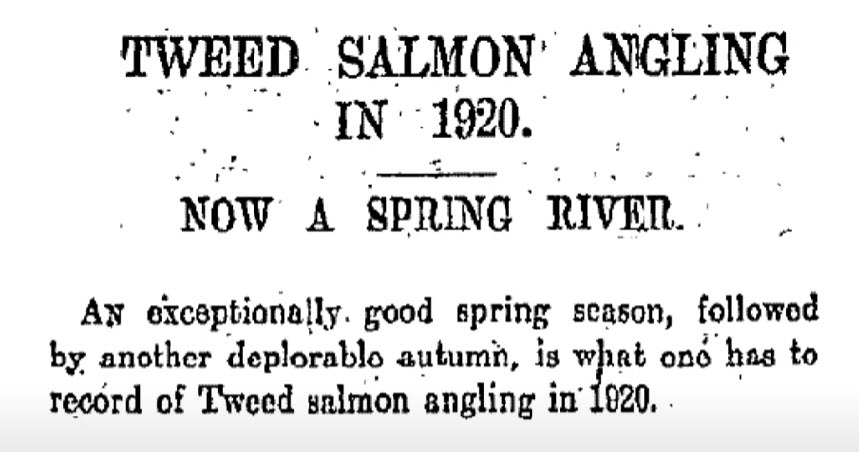Ill-informed?: At the end of last month, the Stornoway Gazette reported that Scottish Green MSP Ariane Burgess had urged the Scottish Government to do more to preserve wild salmon stocks. This followed a meeting of the Scottish Parliament’s Rural Affairs Committee which had met to discuss the 2024 amendments to the salmon conservation regulations. Ms Burgess later said that wild salmon populations are in crisis. She cited two iconic rivers in Lewis, the Laxdale and Blackwater as examples of how populations are in decline.
Ms Burgess has also been in the news herself recently. Salmon Business report that she has been criticised by Scottish Sea Farms for questioning the sustainability and environmental impact of a proposed new farm at Holm in Shetland. She cited potential seabed damage and compared the waste output of 6,000 tonnes of salmon to that of a town ten times the size of Lerwick. In response, Scottish Sea Farms have said that ‘it’s more than a little alarming that an elected official from a party whose slogan is ‘For people, for planet’ can remain so resolutely ill- informed.’
This is not surprising, since Ms Burgess seems to prefer to hear the views of community groups like Coastal Community Network. She certainly wasn’t interested in reading reLAKSation as she unsubscribed from the mailing list. She also seems reluctant to respond to any attempts to correct her poor knowledge of salmon. However, it is not just farmed salmon where her knowledge leaves much to be desired.
In my opinion, Ms Burgess may not have been paying attention in the Parliamentary Rural Affairs Committee meeting on salmon conservation, otherwise it is puzzling how she came to cite the Laxdale and Blackwater rivers as examples of how salmon populations are in decline.
This is because both the Laxdale and the Blackwater saw their conservation gradings increase from a Grade 3 to a Grade 2 for the 2024 fishing season. This means that in the eyes of the Marine Directorate these rivers have increased the probability of meeting their conservation limit from less than 60% to between 60% and 80%. In practice this means that although anglers should return the fish they catch, they can if they want, chose not to, and retain the fish for the pot. In other words, the Marine Directorate believe that there are sufficient fish in these rivers to allow anglers to catch and kill some. The 2024 conservation assessment estimates stock in 2022 to be about 60 fish, which seems a very small number to allow any exploitation. Perhaps, Ms Burgess should look at the documentation she and other MSPs approved before speaking out.
Ms Burgess told the Stornoway Gazette that wild salmon are an iconic species in Scotland and are particularly of economic importance to rural communities through angling and tourism. She said that she is clear that angling is not the primary cause of wild salmon decline but as the changes to salmon conservation will allow increased catching and retention in seven rivers (33 fisheries are now Grade 1 or 2 within the salmon farming area and thus could all potentially allow anglers to kill the fish they catch), then it is even more important that action is taken on the primary pressure affecting wild salmon including fish farming. Simply put, Mrs Burgess appears to be saying that increased measures should be taken against salmon farming to protect every wild salmon, so they are available for anglers to catch and kill for their sport and to ensure that local communities remain economically viable. If in doubt, she added that ‘we can’t afford to let Scotland’s wild salmon slip away forever. We need to urgently accelerate reforms to salmon farming, limit pollution and protect river habitats so our rural communities can continue to benefit from this keystone species’.
Despite the Green’s slogan, ’For people, for planet, Ms Burgess is clearly more concerned about some people more than the planet because she appears uninterested in safeguarding wild salmon, unless they are available for anglers to exploit.
Finally, for many reasons, it is clear that salmon farming is not responsible for the decline of wild salmon. Certainly, there is no hard evidence to suggest that salmon farming is to blame. By comparison, it is possible to chart the exact number of wild salmon that have been caught and killed by anglers from all 109 fishery districts since 1952. Perhaps, Ms Burgess would like to provide similar evidence about the impact of salmon farming.
Chinook: A story that seems to have failed to gain any prominence was reported by Business in Vancouver (BIV) recently. Average returns of chinook salmon to the Thompson-Shuswap System, northeast of Vancouver have typically been around 75,000 to 100,000 fish. In 2023, the number of chinook salmon returning totalled 627,000 fish. The Sport Fishing Institute have said that key stocks across BC have rebounded leading to an abundance of chinook that has not been seen in decades or maybe ever. Whilst there have been some conservation measures in place, not least because chinook salmon are the favoured food of killer whales, the reason for the good numbers is thought to be favourable oceanic conditions.
What is surprising is the seeming lack of interest from the Canadian wild fish sector about this news. Of course, it doesn’t fit in with their claims that salmon farming is killing wild fish. Even more surprising is the seeming silence from anti-salmon farming campaigner Alexandra Morton, given that her first love and the reason why she ended up in Canada was the local killer whale populations. The fact that abundant food has arrived for the orcas seems to have passed her by.
Earlier this month she had written to the Fisheries Minister continuing to complain that, in her opinion, the DFO had carried out research fraud when declaring that salmon farms are not a significant risk to wild salmon. She again reiterated that 16 scientists, who she said are leaders in fisheries science, had questioned the DFO findings. Perhaps if these fisheries scientists were parasitologists instead and knew something about sea lice then their view might be more respected.
Whilst looking for any comments about the resurgence of chinook salmon on her webpage, I also noticed a second letter to the Fisheries Minister written in January. In this she thanks the Minister for travelling to BC, especially during the winter but that she greatly regretted not being able to take up her offer to meet because her grandchildren had given her a cold.
I would have thought that given her passion for attacking salmon farming, she would have taken up this opportunity to meet the one person who could effect change, even if it meant going out with a sniffly nose.
Ms Morton has always been reluctant to meet opponents and now it seems that she found any excuse not to meet even those that might be of help. Perhaps, if the Minister wants to help wild salmon, then she could do no worse than arrange to get interested parties together in the same room so she can hear both sides of the story at the same time.
Meantime, I wish Ms Morton well for a full recovery. Surely, the happy news of the return of the chinook should brighten up her days.
King’s river: It is very difficult to predict the future, but it is possible that in thirty or forty-years’ time, there could be over 300 land-based fish farms dotted around Scotland’s coast located next to almost every salmon river. This could be the vision for Scotland if the Atlantic Salmon Trust’s latest attempt to revive the fortunes of wild Scottish salmon are successful.
The Times newspaper reports on a new project that aims to restore wild salmon stocks on the river Dee, which runs by Balmoral Castle and where according to the paper, Charles enjoys fishing for salmon. The Atlantic Salmon Trust of which the King is patron is working in partnership with the River Dee Trust and the Dee District Salmon Fishery Board to launch the ‘Save the Spring’ initiative, a 20-year programme of work to restore and future-proof the upper river Dee catchment, a heartland of spring salmon.
According to the project team, some of the river’s spring run Atlantic salmon sub-populations are now at risk of extinction. They cite an ‘alarming example’ of the Girnock Burn, which is dominated by spring-run multi-sea winter Atlantic salmon but has recorded a decline in the number of female fish returning to spawn from as many as 150 fish in the 1960s to just two individuals in the autumn of 2023.
Ten years ago, Marine Scotland published their second report on the stock status of salmon and sea trout in Scotland. This annual reporting then stopped, presumably because Marine Scotland needed to direct their efforts to the assessment of conservation limits. In this report, Marine Scotland discussed the trends of spring, summer and autumn salmon but have rarely done so since, except in relation to spring running fish, the numbers of which has been in decline for decades, whilst numbers of later running fish have generally increased.

I personally would question whether this project will succeed in trying to restore numbers of these early running fish because whilst there is clearly something going on at sea, which is affecting all wild salmon, salmon are clearly subjected to other long-term factors which are not always apparent to today’s anglers and fisheries scientists, especially as they tend to be more focused on other issues.
The You Tube video the History of Tweed salmon is a mine of information about what has happened to salmon in the past. One reference is an article in the Scotsman newspaper dated 9th December 1920 which was headlined that the river Tweed is now a spring salmon river. Presumably, the river was not considered to be a spring salmon river before then. This is not surprising when the graphs published by Marine Scotland in their status report are considered. These remind me of the long-term changes in large salmon and grilse numbers which I discussed in my published peer-reviewed paper two years ago. Could it be that the lack of spring fish in the river Dee are simply due to such long-term changes that affect the salmon population and thus any remedial efforts will never succeed until whatever causes these changes reverses. Whether they will, given the overall declines in wild salmon numbers remain to be seen but the simple fact is that we are probably in a time when spring salmon numbers are naturally low.

In addition to improvements to habitat restoration in the upper Dee, the project aims to begin a closely monitored wild fish repopulation to boost salmon populations. This will involve reconditioning post spawn wild adult salmon. These fish will be caught after spawning naturally and transferred to a tank-based facility at the University of Stirling and grown back to breeding condition and then released back into the river to spawn naturally a second time.
A second approach will be to take wild smolts and grow then up to adulthood and reproductive maturity and then releasing them back into the river as adults to spawn.
Either approach will require what is effectively a ‘fish farm’ to grow or recondition the fish and if successful, every river will require a separate ‘farm’ because as the project team say, both approaches place an emphasis on maximising wild spawning behaviour and hatching of wild juvenile salmon so care and attention is needed to preserve the river Dee’s genetic portfolio within the salmon sub-populations to enable then to adapt to future environment change and minimising the negative impacts of domestication associated with traditional hatchery practices.
Clearly, if the river Dee partnership aim to maintain the genetic integrity of the fish in their river, so will those who administer every other river in Scotland. Hence the need for a ‘farm for every river in Scotland, irrespective of the approach taken. Of course, by the time that the project comes to an end in twenty years’ time, it is just as likely that salmon will have disappeared from many rivers and therefore the need for genetic integrity will have long passed (if it ever existed at all).
Finally, it will be interesting to see if the AST, by becoming salmon farmers (whichever way they describe it, that is what it is) will change their view on salmon farming.

